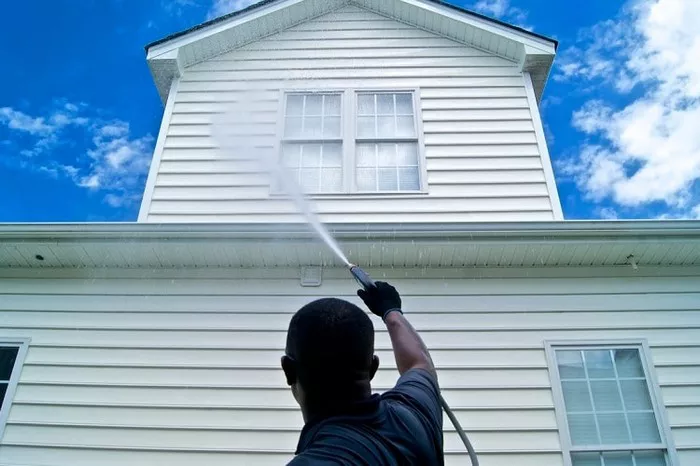Power washing is a versatile tool for cleaning various surfaces around your home, but when it comes to delicate surfaces like windows, there’s a bit of hesitation. Can you power wash windows without damaging them? This guide will walk you through the process, providing tips and precautions to ensure a clean and streak-free result.
Understanding Power Washing
Power washing, also known as pressure washing, involves using a high-pressure stream of water to clean surfaces. The equipment typically includes a motorized pump and a nozzle that concentrates the water into a powerful jet. While it’s excellent for cleaning tough stains on durable surfaces like concrete or brick, the high pressure can potentially damage more delicate materials like wood or glass if not used correctly.
Can You Power Wash Windows?
Yes, you can power wash windows, but with caution. The high pressure from the power washer can easily break the glass or damage the window frame if used improperly. However, with the right technique and equipment, power washing windows can be efficient and effective.
Preparation
Before you begin power washing your windows, it’s essential to prepare the area properly:
1. Inspect the Windows: Check for any cracks or damage to the windows or frames. Avoid power washing windows that are already damaged, as the high pressure could worsen the problem.
2. Cover Surrounding Areas: Use plastic sheeting or tape to cover nearby plants, furniture, or electrical outlets to protect them from overspray or water damage.
3. Choose the Right Equipment: Use a pressure washer with an adjustable nozzle and lower pressure settings specifically designed for cleaning windows. A nozzle with a wide spray pattern will help distribute the pressure more evenly and reduce the risk of damage.
4. Use the Right Detergent: Use a mild detergent specifically formulated for use with pressure washers. Avoid harsh chemicals that could damage the glass or surrounding surfaces.
Technique
When power washing windows, it’s crucial to use the right technique to avoid damage and achieve the best results:
1. Start with Low Pressure: Begin with the lowest pressure setting on your pressure washer to test the water pressure and adjust as needed. High pressure is not necessary for cleaning windows and can increase the risk of damage.
2. Keep a Safe Distance: Maintain a safe distance between the nozzle and the window surface, typically around 12 to 18 inches. Getting too close can increase the pressure and risk of damage.
3. Use a Smooth Motion: Move the nozzle in a smooth, sweeping motion across the window surface, overlapping each pass slightly to ensure thorough coverage. Avoid staying in one spot for too long to prevent streaking or damage.
4. Work from Top to Bottom: Start at the top of the window and work your way down to ensure that any dirt or debris is washed away from the surface rather than being pushed back onto it.
5. Rinse Thoroughly: After cleaning, thoroughly rinse the windows with clean water to remove any detergent residue or loosened dirt.
Post-Cleaning Care
After power washing your windows, there are a few additional steps you can take to maintain their cleanliness and prolong their lifespan:
1. Inspect for Damage: Once the windows are dry, inspect them again for any signs of damage or water infiltration. Repair any cracks or leaks promptly to prevent further issues.
2. Apply a Protective Coating: Consider applying a protective coating or sealant to the windows to help repel dirt and water and make future cleaning easier.
3. Regular Maintenance: Schedule regular window cleanings to keep them looking their best and prevent dirt and grime buildup.
Conclusion
Power washing windows can be a safe and effective way to clean them, but it requires careful preparation, the right equipment, and proper technique. By following the steps outlined in this guide, you can achieve clean, streak-free windows without causing damage. Remember to always prioritize safety and take your time to ensure the best results.
FAQs
Q1: Can I use a regular pressure washer to clean windows?
A1: While you can use a regular pressure washer to clean windows, it’s essential to use caution and the appropriate settings. Opt for a pressure washer with adjustable pressure settings and a wide spray pattern nozzle to reduce the risk of damage to the windows.
Q2: How often should I power wash my windows?
A2: The frequency of power washing windows depends on various factors such as location, weather conditions, and the level of dirt and grime buildup. As a general rule, aim to clean your windows at least once or twice a year to maintain their appearance and prolong their lifespan.
Q3: Are there any alternatives to power washing windows?
A3: Yes, there are alternatives to power washing windows, such as using a squeegee and a cleaning solution or hiring a professional window cleaning service. These methods can be gentler on the windows and may be more suitable for delicate or hard-to-reach areas.

